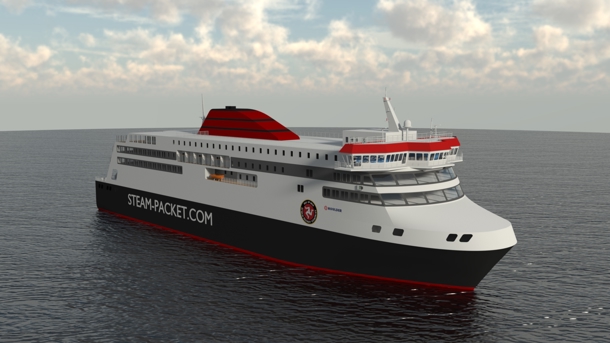Due to tidal conditions on our current berths in Heysham Port, the following sailings have been rescheduled. Tuesday 12th November Heysham to Douglas 03:00hrs – This sailing will now depart at 03:30hrs Wednesday 13th November Heysham to Douglas 01:30hrs – This sailing will now depart at 00:50hrs
Find out moreDesigning & Constructing a New Vessel: Part One
19 January 2021 By Isle of Man Steam Packet Co.
As most of you will know, the Isle of Man Steam Packet Company is in the process of designing a new and bespoke vessel. This will take over from our conventional ferry Ben-my-Chree, which will then become our backup vessel. The new ship has already been named ‘Manxman’.
Due to arrive in the Island in spring 2023, this major investment involves a huge amount of resources, meticulous planning and organisation and collaboration with many specialist companies to ensure the project stays on track, within the projected timeframe and to budget. With so many different stages involved from initial analysis through to construction of the vessel, we wanted to give you an insight into the process including the work that has already been undertaken and what will be happening behind the scenes over the next few years.

In part one of this two-part blog series, we will be looking at what is involved in the planning, design and construction of a bespoke ferry and the different steps involved in the process.
To help provide an insight into each stage, we have broken down each step below including an approximate timescale for each stage. Note that the timings are specific to the development of our vessel.
1. Initial Analysis – Approx. 6 Months
This vital stage involves defining what is required from the vessel in terms of passenger capacity, freight capacity, speed and so on, in addition to taking restrictions such as length, draught and berthing constraints into consideration.
2. Statement of requirements drawn up – Approx. 1 Month
From the detailed analysis, a statement of requirements is drawn up which outlines specifically what is needed from the new vessel.
3. Concept design and outline specification – Approx. 3-4 Months
Once the statement of requirements is agreed by the owner, it is over to the highly skilled naval architects to develop concept designs and outline the specification of the vessel to satisfy the brief.
4. Shipyards submit expressions of interest – Approx. 2-3 Months
It is at this point that prospective shipbuilding yards will submit expressions of interest to tender for the new build process. Each yard is reviewed by the owner on merit and, if suitable, will be offered the opportunity to tender.
5. Tender – Approx. 3-4 Months
Approved shipyards will review the concept design and specification and supply a tender based on a rough order of magnitude, which is an estimate of cost and time to build the ship. It is during this period that surveys of the public and service users are undertaken to work out priorities and ensure that the needs of all stakeholders are considered from the earliest stages. The concept specification is updated to reflect the findings of the survey.
6. Shipyard review and shortlist – Approx. 1-2 Months
Once all tenders have been received, each is reviewed in detail by the owner in terms of cost, proposed timings, build quality, shipyard experience, risk assessment and many other important factors. A shortlist of four to five yards which best meet the requirements is then produced.
7. Shipyard visits – Approx. 1-2 Months
Once the shortlist is agreed, senior managers will visit each prospective yard to get a feel for how they operate and assess their facilities, work quality, processes, safety records, quality management and more, in addition to meeting with the design team to ascertain if they have a good understanding of the owner’s needs.
8. Yard selection – Approx. 1-2 Months
Following the shortlisted visits, an extensive review of each shipyard and evaluation of more accurate cost estimations, a final decision on where the vessel will be constructed is made by the owners.
9. Contract and technical discussions – Approx. 1-2 Months
Once the shipyard has been selected, detailed discussions take place between the buyer and builder to ensure each party is on the same page and agrees exactly what is going to be built – the result of which is the signing of a shipbuilding contract.
10. Detail design – Approx. 12 Months
This is a crucial phase in the process, with lots going on and many important decisions to be made. Shipyard designers will turn the concept design, ship building specification and shipbuilding contract into a 3D detailed design drawing of the vessel, in addition to construction drawings to allow the vessel to be built.
In the meantime, interior designers will be working on the internal layouts, design direction and materials to be used. Vessel equipment selection is also going on, while the shipbuilder gathers detailed specifications and prices for all machinery and equipment, which will then be presented to the buyer for approval.
11. Steel cutting – Approx. 2 Months
Once everything has been approved, the early stages of the build process can begin. From the detailed construction drawings, plasma files are produced which allow the shipyard’s plate cutting machines to automatically and accurately cut each piece of the vessel.
12. Block construction – Approx. 4-5 Months
Sections of the vessel, known as blocks, are constructed by welding together the cut plates which are then blasted and painted. During this stage some of the outfitting is also installed such as pipes, cable trays and foundations.
13. Keel laying and construction – Approx. 4-5 Months
The vessel starts to come together as the keel is laid and blocks are welded together in the dock, marking the official start of the ship’s construction. As the blocks are welded together, large items of machinery such as the main engines are installed.
14. Launch – Approx. 4-5 Months
The construction process is at this point in its very final stages! The completed hull is launched and moved to a fitting-out key, where final installation of interior equipment is completed and the ship’s systems are commissioned and tested.
15. Sea Trials – Approx. 2-3 Months
The vessel is now fully tested and ready to go to sea. Speed and manoeuvring trials are completed to prove the vessel can achieve contract speeds in varying conditions, and the vessel crew undertakes extensive training to ensure it can operate all systems safely and securely.
16. Delivery
Once all systems are tested and sea trials have been successfully completed, the vessel is handed over from builder to buyer and is able to make its journey to its new home.

As you can see, there is plenty to consider and the process of designing and constructing a bespoke vessel is no easy feat, but it is a very exciting project which is progressing exceptionally well and we are looking forward to the next stages in its development.
Keep an eye out for part two of this blog series, which will give an insight into how long the process usually takes, the types of specialist organisations we will be working with along the way and the challenges the Company faces over the next few years.

Get the latest deals and offers
Join our mailing list to receive early-bird offers, exclusive deals and travel inspiration.